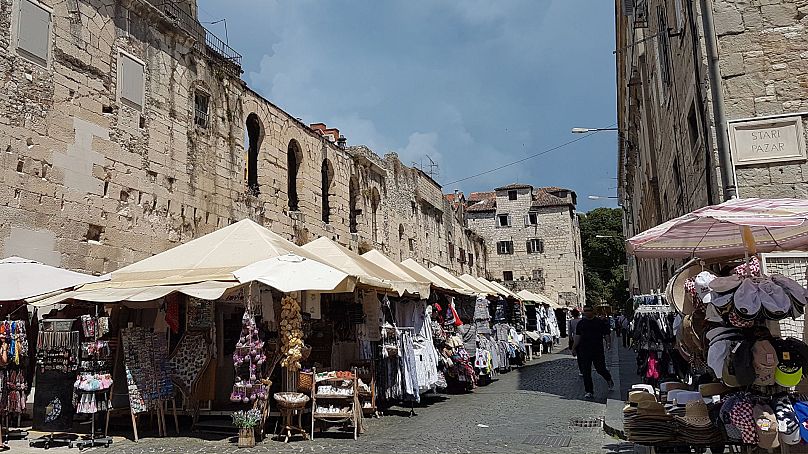Soaring rent, drunken behaviour and peeing in public: Split locals have had enough of party tourists

Split has long had a reputation as a party destination. But locals have had enough of the drunk tourists who descend on the coastal Croatian city for music festivals like Ultra Europe.
“Lots of younger people come for that, they’re not buyers, they’re only here for partying and alcohol, not islands or tours,” says Vana, a cruise company employee.
That’s not the only way they hit the local economy. Short-term visitors who stay for just a few months have sharply driven up rents in Split, which now average between €700 to €800. Given that the average monthly salary is around €1,000, this has put a strain on those who live there.
“It’s becoming harder for younger people to find a flat, start their lives, or have a family,” says Vana. While short-term letting in the winter provides extra income, it backfires in summer when “it can get very expensive”, she adds.
The city has also had to ramp up security and police presence to “watch for antisocial behaviours like public drinking, peeing or people with their shirts off”.
‘We don’t want to be known as as a party destination’
Split’s hedonistic image isn’t just an economic strain: it’s eroding the city’s identity.
“There used to be more restaurants, bars and cafes serving local food, but now they mostly have tourist food,” says Veronica, a recent graduate who now works at a day trip company.
“Split has changed a lot in the last 10 years,” agrees Luce, another tour operator. “The promenade had a lot more local cafes and restaurants. Now, it’s all Italian, burgers, etc, even though Croatians are best at Croatian food.
“The [Diocletian's] Palace [area] had small independent shops, now it’s mostly apartments which are given out to tourists on rent, or for short stays,” she adds.
But tourism workers recognise the good that comes with the bad.
“Tourism in Split is, from one point of view, very good, especially in the Old Town and Diocletian’s Palace, which has been 95 per cent renovated, so it is now quite new,” says Ivana, a guesthouse receptionist.
“However, the bad thing is that the people who lived in the Old Town, in old flats, are now not living there.”
Veronica links this shift to the influx of “younger tourists, who all come for music festivals” - driving locals out and prices up.
“Locals don’t like to hang out in the city centre much, because it’s so full and expensive. We are mainly spread out all over Split, outside the city centre,” she says.
It hasn’t always been this way, she recalls. “There used to be a lot nicer, polite tourists before, with families - we like them, we have no problem with tourists like this.”
But this summer, they were nowhere to be seen. While apartments, hostels and motels were full, “hotels were a bit emptier, as high class tourists were less”, says Veronica.
‘We depend almost entirely on tourism’
Regardless of how tourists behave, there’s no denying that Split is reliant on them.
“We depend almost entirely on tourism, which is not very good, but is what it is,” a local shopkeeper tells Euronews Travel. “There are a few issues in the Old Town. It’s either a lot of people in summer or no people in winter, not much middle ground.”
Many locals make the bulk of their yearly income in the busy summer season, helping them to ride out the quieter winter months, when there are far fewer jobs and hardly any tourists.
“We are selling them expensive boat tours, for the price of which they can buy their plane tickets and accommodation,” says Kristina, another cruise company employee.
“Even if the city wants to reduce tourism, there’s too much support from bars and restaurants,” adds Veronica.
“So this is the difference, in some cases, you gain something, and in others, you lose,” says Ivana. “We don’t have the same thinking as Spain or other countries, since tourism in Split only started about 16 years ago. So we like tourists here.”
What is Split doing to make tourism more sustainable?
In Spanish tourist hotspots, local authorities are resorting to extreme measures to curb overtourism - including raising tourist taxes and promising to ban short-term apartment rentals to tourists in Barcelona.
Closer to home, Dubrovnik has also limited tourist numbers to 4,000 a day, installed more security cameras around the city, and staggered cruise ship arrival and departure times.
Aware of growing tensions in Croatia’s second city, the Tourist Board of Split commissioned a comprehensive ‘Study of the Tourism Carrying Capacity of the City’ in 2022.
It examined whether local infrastructure and accommodation was adequate to handle the 900,000 tourists the city welcomes each year.
Finding that overtourism was most pronounced in the crowded city centre, officials have begun regulating the number and type of accommodation options, based on carrying capacity calculations.
They have also employed more security services and municipal wardens to curb anti-social behaviour like excessive noise, public drinking and urinating in public places, especially in the Old Town.
Accommodation providers have been encouraged to join in these efforts by setting clearer house rules and expectations for guest behaviour, especially when it comes to younger tourist groups.
Other initiatives include the ‘Respect & Enjoy’ campaign, which helps hotels, agencies and tour operators to promote responsible tourism.
It also includes measures to attract tourists outside of the peak summer months - an important shift for locals like Veronica whose income is restricted by the seasonal nature of tourism in Split.
“We are committed to finding the right balance between supporting a thriving tourism industry and preserving the quality of life for the residents of Split,” the Tourist Board of Split tells Euronews Travel.
“Our goal is to ensure that tourism development is socially, ecologically, and economically sustainable, with a strong emphasis on improving the quality of life for residents.“



